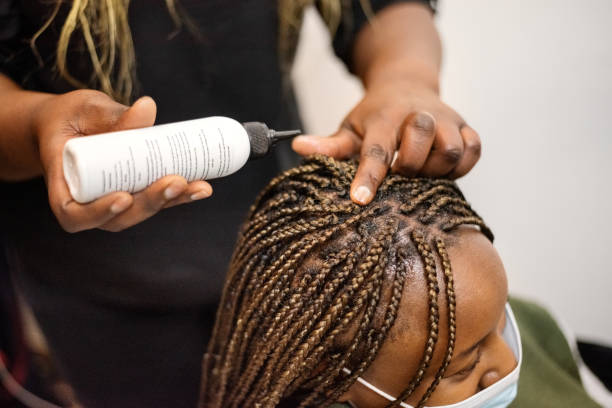If you've ever had braids, you're probably familiar with "braids itch?" It's a common issue, especially after getting fresh braids. While braids are an incredible protective style, they can leave you with an itchy scalp, which can be irritating and uncomfortable. Why does this happen, and what can you do to prevent or stop it? In this blog, we'll dive deep into the causes of braid itch and explore effective remedies to keep your scalp happy and healthy. So, let's unravel the mystery behind that itching sensation and how you can avoid it!
Why Does Braids Itch Happen?
Many braid lovers ask. Braids can be tight and heavy, which leads to an uncomfortable sensation. There are multiple reasons behind this, and most of them are quite common. Itching after braids can range from mild irritation to severe discomfort, depending on how your scalp reacts to certain factors.
Scalp Tension from Too Tight Braids
One of the leading causes of braids itch is too much tension. Tight braids may look neat, but when your scalp is under constant stress, it can become sore and irritated. When the hair is pulled too tightly, it not only causes discomfort but also strains your hair follicles. This can result in inflammation and an itchy scalp, especially if the braids pull at the roots.
Hair Follicle Strain
Tight braids pull on the hair follicles, making the scalp feel tense. This tension creates tiny injuries in your follicles, leading to itchiness as your scalp reacts to the trauma. In severe cases, the pulling can cause small bumps around the braided scalp, a sign that the tension is causing significant strain on your skin.
Tension, Headaches, and Pain
Beyond the itchy feeling, tight braids can also cause headaches and throbbing pain. If you've ever felt a dull ache after braiding, it's likely because your scalp is fighting against the excessive tension. The pain can spread from your scalp to your forehead or even down your neck, making the whole experience unpleasant.
Product Buildup Before Braiding
Braiding your hair often involves the use of various hair products like oils, leave-in conditioners, and creams. While these products help moisturize and protect your hair, they can also lead to buildup if not washed properly before braiding. This buildup can clog your scalp's pores and irritate your skin, leading to itching.
Improper Pre-Braiding Cleansing
Many people need to properly clean their scalp before getting braids. If dirt, product residue, and oils aren't thoroughly removed before installation, they can mix with sweat and create an itchy situation. Make sure to use a clarifying shampoo to remove all buildup before braiding.
Sweat and Dirt Accumulation
Once your hair is braided, your scalp doesn't get as much air circulation. Add to that the natural oils your scalp produces, and you have a recipe for itchiness. Regular scalp cleansing after braiding can help reduce the chances of dirt and sweat buildup.
Synthetic Hair Reactions
If you're braiding synthetic hair extensions, you may be allergic to the fibres. Synthetic hair is often treated with chemicals to preserve it and give it that glossy, sleek look. Unfortunately, these chemicals can cause itching, dryness, or even flaking of the scalp.
Chemical Residue in Synthetic Hair
Many synthetic hair extensions contain alkaline chemicals, which can cause a reaction on sensitive scalps. Before using synthetic hair, it's wise to soak it in a mixture of apple cider vinegar and water to neutralize the chemicals. Rinse it thoroughly before installation to help prevent any scalp irritation.
Alternative Solutions
If you're prone to allergic reactions, consider using human hair extensions instead of synthetic ones. Human hair is less likely to cause a reaction, though it can be more expensive. Alternatively, you can look for hypoallergenic synthetic hair designed for sensitive scalps.
Let's now explore more about [synthetic Blonde wigs] in more detail.
How to Make Tight Braids Without Damaging Your Scalp
Tight braids may last longer and look more polished, but how can you achieve that without damaging your scalp or causing unnecessary discomfort? The key lies in technique and preparation. You don't have to sacrifice comfort for style.

Use the Right Technique
If you're braiding your hair, be mindful of how much tension you're applying as you braid. Avoid pulling the hair too tightly against the scalp, especially near sensitive areas like the hairline. You can still achieve a neat look without over-stressing your scalp.
Section Your Hair Properly
Divide your hair into even, manageable sections. Smaller sections often require less tension to braid securely, while larger ones may need more pulling. Be consistent in your braiding technique across all sections.
Secure the Ends Lightly
Focus on securing the ends of the braids firmly without pulling on the roots. This helps keep the braid tight without causing too much stress on the scalp.
Avoid Excessive Tension on the Hairline
Your hairline, especially around the forehead and temples, is the most delicate part of your scalp. Over time, too much tension on the hairline can lead to hair loss (traction alopecia), and in extreme cases, the damage may be irreversible. Always braid more loosely around these areas.
Protect Your Edges
You can leave out a small section of your hairline to avoid stressing it. If you must braid the edges, keep the tension light to prevent pulling.
Gradually Tighten the Braids
You don't need to make the braids super tight from the start. Gradually tightening them as you braid will help reduce the tension on your scalp. Once the braids are done, you can lightly adjust any sections that may feel loose without causing major discomfort.
Risks of Too Tight Braids and How to Avoid Them
While tight braids can give a clean and polished look, there are several risks involved if the braids are consistently done too tight. It's crucial to be aware of these risks so you can protect your scalp and hair health.
Traction Alopecia (Hair Loss)
Traction alopecia is a type of hair loss caused by constant tension on the hair follicles. It typically affects areas with the most pulling, like the hairline. The early stages are reversible, but if you continue to wear tight styles, the hair loss may become permanent.
How to Prevent Traction Alopecia?
The best way to avoid traction alopecia is to give your hair a break from tight styles and alternate between protective styles. If you notice thinning or hair loss around your edges, it's a sign that your braids are too tight, and you should address it before it becomes severe.
Scalp Inflammation and Sores
Constant tension can lead to scalp inflammation and even sores in severe cases. If your scalp is red, tender, or has small bumps, it's a sign that your braids are too tight. If not treated properly, this can result in infections.
Managing Scalp Inflammation
If you notice inflammation, remove or loosen the braids as soon as possible. You can also apply an anti-inflammatory oil like tea tree oil to soothe the scalp and reduce redness.
How to Braid the Scalp Without Causing Irritation?
Knowing how to braid your hair or have it braided without irritating can make all the difference in your comfort. Here are some essential tips to keep your scalp itch-free.

Prepare the Scalp Before Braiding
Before braiding, make sure your scalp is in good condition. Start with clean, moisturized hair, as this will reduce the chances of irritation later on.
Cleanse Thoroughly
Use a clarifying shampoo to clean your scalp and hair, removing any buildup from previous products. This ensures that your scalp can "breathe" during the braiding process.
Deep Condition Your Hair
Applying a deep conditioner or leave-in conditioner before braiding keeps hair hydrated and helps prevent scalp dryness.
Moisturize the Scalp Regularly
Once your braids are in, remember scalp care. Regular moisturizing helps prevent dryness, which often leads to itching.
Light Oils for Scalp Hydration
Use light oils such as jojoba, coconut, or tea tree oil to keep your scalp hydrated. Avoid heavy oils that can clog your pores.
Use Gentle Products
When washing your scalp while braided, use mild shampoos and conditioners that are sulfate-free. Harsh products can strip your scalp of its natural oils, leading to dryness and irritation.
Hydrating Scalp Sprays
Consider using scalp sprays that contain soothing ingredients like peppermint or aloe vera. These sprays are designed to provide hydration without causing buildup.
Let's now explore more about [Make wigs look real] in more detail.
How Long Should Braids Stay In to Avoid Scalp Issues?
Leaving your braids in for too long can lead to more issues than just itching. There's a time frame that works best for keeping your hair and scalp healthy while wearing braids.
Six to Eight Weeks is the Max
Most hairstylists recommend keeping braids in for no longer than six to eight weeks. After this time, hair starts to grow out, and scalp irritation due to a lack of airflow increases.
Why It's Important to Take Breaks
Keeping your braids in for too long can cause your new hair growth to tangle or mat. Additionally, the constant pressure on your scalp for an extended period can lead to long-term damage, including hair thinning and break
FAQs
How can I tell if my braids are too tight?
If your scalp feels painful or tense, or you notice redness around the hairline, the braids are likely too tight. Communicate with your stylist and ask them to loosen the braids if necessary.
How do I stop my braids from itching?
You can stop braids from itching by applying scalp sprays with cooling ingredients like peppermint oil or using an apple cider vinegar rinse. Keeping your scalp moisturized also helps.
Can tight braids cause permanent hair loss?
Yes, wearing overly tight braids repeatedly can cause traction alopecia, which is a form of permanent hair loss. It's important to avoid too much tension on the scalp.
How often should I wash my scalp when I have braids?
When you have braids, it's good to wash your scalp every 1-2 weeks. Use a diluted shampoo and gently cleanse to avoid disturbing the braids.
Conclusion
Dealing with braids itch can be frustrating, but it's often preventable and treatable. The key lies in making sure your braids aren't too tight, keeping your scalp clean and moisturized, and using the right products. With these tips in mind, you can enjoy your braids without the discomfort!


